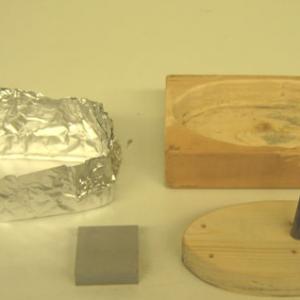College of Liberal Arts & Sciences
2B40.28 - Metal & Concrete Boats - Buoyancy vs. Surface Area
Cut a large piece of aluminum foil and fold it in half. Press this into the boat mold and cut off the excess so that the boat is 1 to 2 inches high. Place this into the Plexiglas tank and observe how it floats. Add aluminum blocks as desired. Take the boat out of the water and crush into a small cube with a hammer. When placed back into the water this cube will sink even though it has the same mass as the original hull.
Several concrete boats are available. Gently place them into the water. Masses up to about 500 grams can be added as long as you are careful when placing the masses so that you don't tip the boat.
A non-boat version of this is to place an ice cube in a beaker of salad oil. The ice cube will float about half way down. As it melts, it will continue to sink in the salad oil.
- Francisco Jose Torcal-Milla, "Can 1 kg of Iron Float on Water", TPT, Vol. 61, #8, Nov. 2023, p. 644.
- Gregory A. DiLisi and Richard A. Rarick, "Remembering the S.S. Edmund Fitsgerald", TPT, Vol. 53, #9, Dec. 2015, p. 521.
- Phong T. Vo, "Archimedes in Action", TPT, Vol. 51, #8, Nov. 2013, p. 498.
- Patrick Dishaw, "Author's Response", TPT, Vol. 48, #6, Sept. 2010, p. 358.
- David P. Stern, "Shipshape Battleships", TPT, Vol. 48, #6, Sept. 2010, p. 358.
- J. Patrick Dishaw, "Battleship Buoyancy", TPT, Vol. 48, #4, Apr. 2010, p. 242.
- Paul Hewitt, "Figuring Physics: Submerged Sub", TPT, Vol. 48, #2, Feb. 2010, p. 88.
- Salvatore Ganci, "A Multipurpose Device for Some Hydrostatics Questions", TPT, Vol. 46, #7, Oct. 2008, p. 407.
- "Figuring Physics", TPT, Vol. 44, # 2, Feb. 2006, p. 117.
- Ludwik Kowalski, "How Does Stable Become Unstable", TPT, Vol. 33, #2, Feb. 1995, p. 70.
- Peter M. Hall, "The Flip Side of Buoyancy", TPT, Vol. 33, #1, Jan. 1995, p. 7.
- Marie Baehr, "Baehr Responds", TPT, Vol. 32, #1, Jan. 1995, p. 7.
- Marie Baehr, "How Stable is Stable", TPT, Vol. 32, #8, Nov. 1994, p. 470.
- R. D. Edge, "String and Stick Tape Experiments", "Battleship in the Bathtub", TPT, Vol. 28, #7, Oct. 1990, p. 510.
- Robert E. Vermillion, "How Not to Sink a Ship", TPT, Vol. 27, #5, May 1989, p. 328.
- Carl C. Fields, "Response", TPT, Vol. 27, #5, May 1989, p. 328.
- Carl Fields, "More on Wooden Boats", TPT, Vol. 25, #7, Oct. 1987, p. 419.
- Richard D. "Aaron A. Abbott" Reed, "Why Do Boats Float", TPT, Vol. 25, #1, Jan. 1987, p. 48.
- "View It", TPT, Vol. 24, #6, Sept. 1986, p. 370.
- Michael A. Hueschen, "Can Bubbles Sink Ships?", AJP, Vol. 78, #2, Feb. 2010, p. 139.
- Erin Brodwin, "Conrete Canoe", Popular Science, Oct 2013, p. 78.
- Rick Beyer, "The Unsinkable Ship", The Greatest Science Stories Never Told, p. 146.
- Curt Suplee, "Making steel float", Everyday Science Explained, National Geographic, p. 50.
- Jim Wilde, "A Concrete Canoe", Popular Mechanics, Sept. 2017, p. 63.
- Prof. Robert Griffith, "Toy Boats", Boy's Useful Pastimes, p. 37.
Disclaimer: These demonstrations are provided only for illustrative use by persons affiliated with The University of Iowa and only under the direction of a trained instructor or physicist. The University of Iowa is not responsible for demonstrations performed by those using their own equipment or who choose to use this reference material for their own purpose. The demonstrations included here are within the public domain and can be found in materials contained in libraries, bookstores, and through electronic sources. Performing all or any portion of any of these demonstrations, with or without revisions not depicted here entails inherent risks. These risks include, without limitation, bodily injury (and possibly death), including risks to health that may be temporary or permanent and that may exacerbate a pre-existing medical condition; and property loss or damage. Anyone performing any part of these demonstrations, even with revisions, knowingly and voluntarily assumes all risks associated with them.
